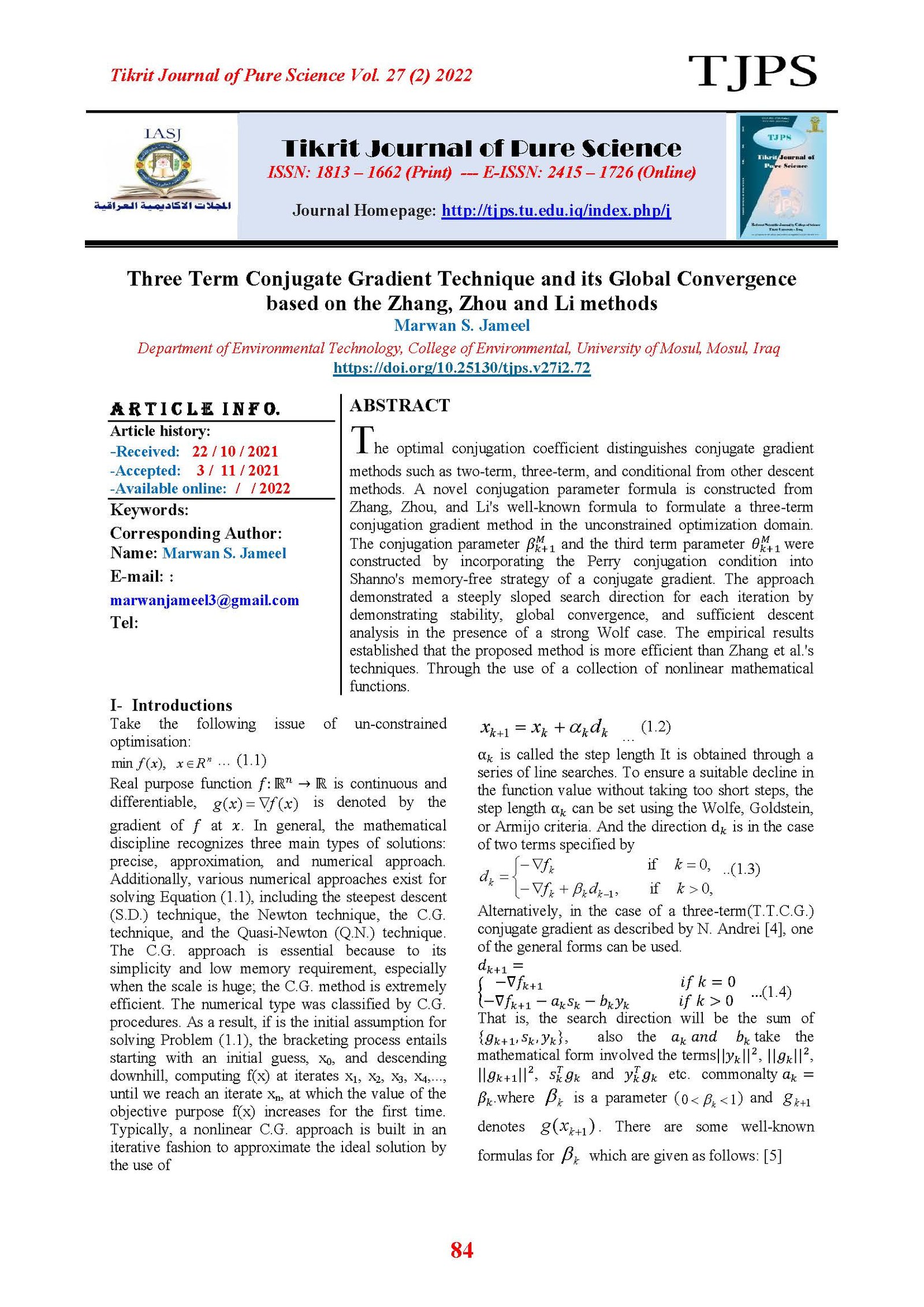Three Term Conjugate Gradient Technique and its Global Convergence based on the Zhang, Zhou and Li methods
Main Article Content
Abstract
The optimal conjugation coefficient distinguishes conjugate gradient methods such as two-term, three-term, and conditional from other descent methods. A novel conjugation parameter formula is constructed from Zhang, Zhou, and Li's well-known formula to formulate a three-term conjugation gradient method in the unconstrained optimization domain. The conjugation parameter and the third term parameter were constructed by incorporating the Perry conjugation condition into Shanno's memory-free strategy of a conjugate gradient. The approach demonstrated a steeply sloped search direction for each iteration by demonstrating stability, global convergence, and sufficient descent analysis in the presence of a strong Wolf case. The empirical results established that the proposed method is more efficient than Zhang et al.'s techniques. Through the use of a collection of nonlinear mathematical functions.
Article Details

This work is licensed under a Creative Commons Attribution 4.0 International License.
Tikrit Journal of Pure Science is licensed under the Creative Commons Attribution 4.0 International License, which allows users to copy, create extracts, abstracts, and new works from the article, alter and revise the article, and make commercial use of the article (including reuse and/or resale of the article by commercial entities), provided the user gives appropriate credit (with a link to the formal publication through the relevant DOI), provides a link to the license, indicates if changes were made, and the licensor is not represented as endorsing the use made of the work. The authors hold the copyright for their published work on the Tikrit J. Pure Sci. website, while Tikrit J. Pure Sci. is responsible for appreciate citation of their work, which is released under CC-BY-4.0, enabling the unrestricted use, distribution, and reproduction of an article in any medium, provided that the original work is properly cited.
References
[1] L. Zhang, W. Zhou and D.H. Li, "A descent modified Polak-Ribi'ere-Polyak conjugate gradient method and its global convergence ", IMA Journal of Numerical Analysis, 26 (2006),629–640.
[2] L. Zhang, W. Zhou and D.H. Li," Global convergence of a modified Fletcher-Reeves conjugate gradient method with Armijo-type line search", Numerische Mathematik, 104 (2006),561–572.
[3] L. Zhang, W. Zhou and D.H. Li, Some descent three-term conjugate gradient methods and their global convergence, Optimization Methods and Software, 22 (2007), 697–711.
[4] Andrei, N. (2013). A simple three-term conjugate gradient algorithm for unconstrained optimization. Journal of Computational and Applied Mathematics, 241, 19-29.
[5] Shanno, D. F. (1978). Conjugate gradient methods with inexact searches. Mathematics of operations research, 3(3), 244-256.
[6] W. Cheng, A two-term PRP-based descent method, Numerical Functional Analysis and Optimization, 28 (2007), 1217–1230.
[7] Theory Appl. Andrei N., "Hybrid Conjugate Gradient Algorithm for Unconstrained Optimization", J. Optim. 141, pp. 249–264, (2009).
[8] Deng, S., & Wan, Z. (2015). A three-term conjugate gradient algorithm for large-scale unconstrained optimization problems. Applied Numerical Mathematics, 92, 70-81.
[9] Yabe H. and Takano M., "Global Convergence Properties of Nonlinear Conjugate Gradient Methods
with Modified Secant Condition", Computational Optimization and Applications, 28, 203–225, (2004).
[10] Bongartz K. E., Conn A.R., Gould N.I.M. and Toint P.L., CUTE: "constrained and unconstrained testing environments". ACM Trans. Math. Software, 21, pp. 123-160, )1995(.
[11] Beale, E.M.L. A derivative of conjugate gradients, in: F.A. Lootsma (Ed.), Numerical Methods for Nonlinear Optimization, Academic Press, London, 1972, pp. 39–43.
[12] Nazareth, L. (1977), A conjugate direction algorithm without line search. Journal of Optimization Theory and Applications, 23, 373-387.
[13] Y. Narushima, H. Yabe and J.A. Ford, A three-term conjugate gradient method with sufficient descent property for unconstrained optimization, SIAM Journal on Optimization,21(2011), 212-230.
[14] Hager W.W. and Zhang H. "A survey of nonlinear conjugate gradient methods", Department of Mathematics, University of Florida, Gainesville, FL, pp. 32611- 8105, (2005).
[15] A. Y. Al-Bayati and M. S. Al-Jameel, "New Scaled Proposed Formulas for Conjugate Gradient Methods in Unconstrained Optimization", AL-Rafidain J. of Computer Science and Mathematics, Mosul, Iraq, vol. 11, no. 2, pp.25-46, 2014.
[16] Zoutendijk, G. (1970). Some algorithms based on the principle of feasible directions. In Nonlinear programming (pp. 93-121). Academic Press.
